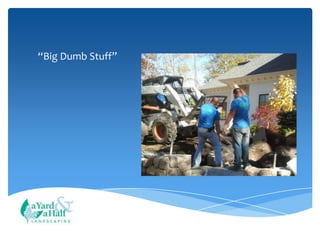Pro Bono Landscape Construction: Building for Change
- 2. The Bones of a Garden
- 4. Many Hands Make Light Work
- 9. It Takes a Village
Editor's Notes
- #2: One designer we work with likes to describe our role as handling the ŌĆ£big dumb stuff.ŌĆØ Yes, we are contractors. And we are proud to do the heavy lifting that brings designersŌĆÖ visions to life. We excavate footings, move boulders, prepare soil for planting, and handle big trees like they were our own 300-pound babies.
- #3: We sweat the small details of construction ŌĆō the pitch of a walkway to direct water away from a foundation; each stone on top of a wall being level and firm. We care about the details because these hardscape elements form the bones of a landscape. When the flowers are gone and the snow comes down, this stone wall remains visible, and the firm soil above it will not sink away.
- #4: But even ŌĆ£big dumb stuffŌĆØ requires preparation to do right. Each winter, we read up on new industry specifications for hardscape, soils, planting, and maintenance. There arenŌĆÖt many courses or materials in Spanish, which is the first language for most folks in our line of work. So, over the years weŌĆÖve developed our own training manuals and classes in-house.
- #5: A job like The ChildrenŌĆÖs Room requires a lot of coordination. Concrete deliveries, irrigation subcontractors, and our crews worked together as a team to ensure that everything would be completed by the planned date for garden planting. Working as an assembly line makes jobs like pouring concrete or laying stone safer, easier, and more fun for everyone.
- #6: ThereŌĆÖs an adage in the organic landcare world, ŌĆ£Care for the soil, and let the soil take care of the plants.ŌĆØ Soil protection and preparation is a key component of every job that we do. A soil test can determine imbalances in organic matter and nutrients. We may also work to remediate compaction or poor drainage. Contractors must also be mindful of the soil throughout construction to prevent further compaction.
- #7: And we wanted the soil to be great because the designer, David McCoy, had plans for the most beautiful plants to bring the garden to life! Plants would change with the seasons, and fill the garden with movement, fragrance, flavors, and wildlife. We love working with clients who want to be IN their gardens, who are open to letting the natural world transform, heal, and teach them.
- #8: The path in the ChildrenŌĆÖs Room garden is its own journey to wholeness, with stepping stones naming steps from grief to healing. This resonated with those of us who worked on the project, recalling our own losses: siblings, parents, a home country, a safe childhood destroyed by war or violence. Community projects like the ChildrenŌĆÖs Room are a way for us to heal a little of that brokenness in the world.
- #9: Our internal motto is, ŌĆ£We change lives!ŌĆØ We like to think we change our clientsŌĆÖ lives by creating enriching outdoor spaces. Our own lives have been changed by having a job that we love, where we are supported in our career goals and enjoy a safe and respectful working environment. And we change lives in the surrounding community by avoiding pesticides, restoring habitats, and building green spaces where people can come together.
- #10: One of the great things about being a part of a COGDesign project is the chance to work as part of a talented, engaged team. COG brings together visionary designers, committed community organizations, energetic volunteers, generous donors, and green businesses, and the whole is always greater than the sum of its parts.
- #11: With sound design, careful preparation, and skilled construction, our installations are meant to last a lifetime. We are glad that COGDesign gives us the opportunity to touch so many lives.










